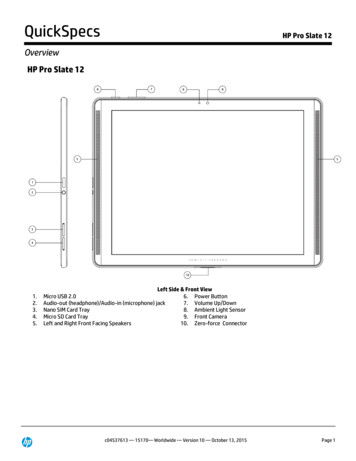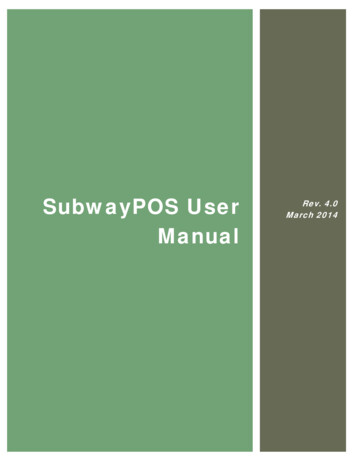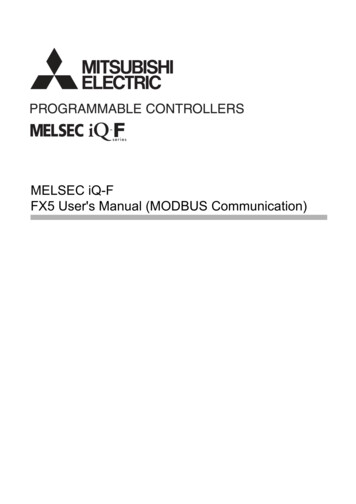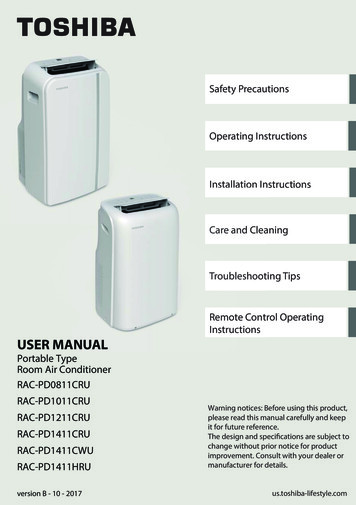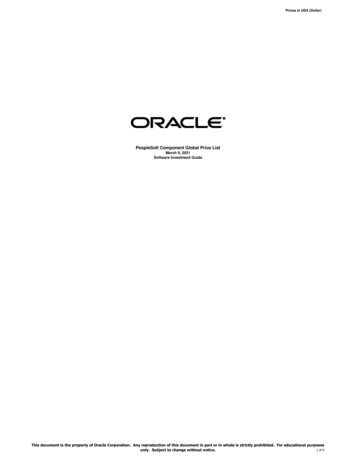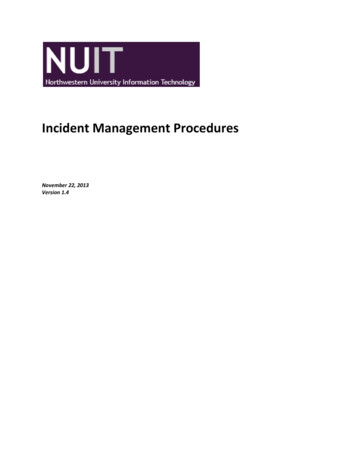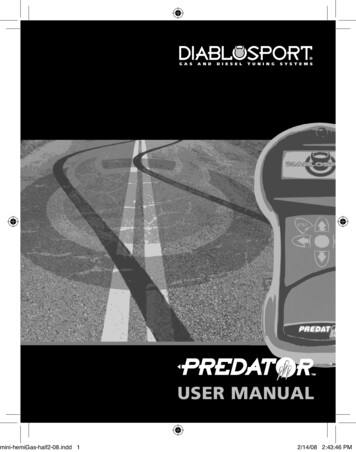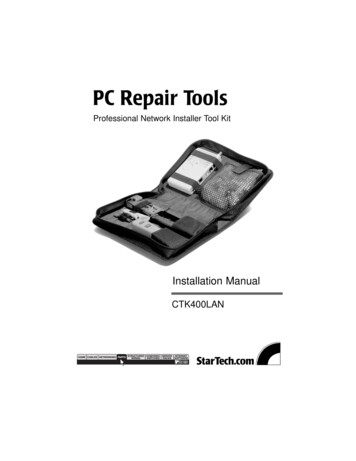
Transcription
PC Repair ToolsProfessional Network Installer Tool KitInstallation ManualCTK400LAN
1OverviewThe StarTech.com Professional LAN Installation Tool kit provides all the necessary toolsto install and test RJ45 networks in a compact, handy, carrying case. Tools included are:a RJ45/11 Crimp tool, a 110/66 Impact Punch Tool, a wire stripper, several RJ45connectors, and a RJ45 network cable tester with remote loopback plug (same as theStarTech.com REMOTETEST tester).Getting StartedUnpacking the CTK400LANThis package should contain:1 x Remote Cable Tester (in own carrying case, same as StarTech.com’s LANTESTPRO)1 x Combo Crimper (same as StarTech.com’s RJ4511TOOL)1 x Punch Down Tool1 x Stripping Tool30 x RJ11 Connectors30 x RJ45 Connectors24 x Boots for Cable Ends (various colors)2 x Blades for Punch Down Tool1 x Carrying CaseBuilding a CableCutting BladeCrimper 8-pinCrimper 6-pin1. Use the Combo Crimping tool to trim both ends of the cables by using the bladeclosest to the handle. Be sure that both ends are cut square.2. Use the trimming blade to strip the jacket off both ends of the cable. thus exposing theindividual color coded conductors.3. Remove a length of jacket so that, when conductors are pushed all the way to thefront of the connectors, the jacket extends under the slot on the connector where thecrimping operation will hold it for strain relief.4. Insert the conductors into the RJ45/RJ11 connector so that the blue conductor goes topin 1.
25. Insert the RJ45/RJ11 plug into the crimping tool as far as possible. There are twomodules: a 6-way one for RJ11 connectors (used on phone jacks) and an 8-way one forRJ45 connectors used on computer jacks. Close the tool as firmly as you can to crimpthe plug into the cable.6. Repeat steps 2- 5 for the other end of the cable.Stripping Copper PairsStripperPunch down tool for use on 110/88 type of termination1. Prepare the wire that you want to strip. Determine the appropriate stripper size byreading the number shown as AWG or MM.2. Open the tool by rotating the lock latch downward.3. Place one end of your wire in the V-groove. Leave approximately 3/8 inch (1 cm) ofwire protruding beyond the edge of the tool.4. Close and lock the stripper. Pull outward to strip off the insulating sheath.5. Open the tool and remove the wire.Note: Be sure that no strands of braid are loose, or they may cause shorts.Seating Wires into Terminal Blocks1. Put the wire into the V-groove, both beside colour coded tips, on the connecting block.2. Use the punch down tool to establish a connection. Put the punch down tool abovethe wire; then, punch the handle of the tool to insert the wire into the connectingblock, and the tool will cut the wire to the appropriate length.3. Repeat these steps for additional wire seating.Testing ConnectivityAfter you finished building up the RJ45/RJ11 connector, you can verify the integrity ofthe connection done by using the remote cable tester provided in the CTK400LAN. Referto the cable tester’s user manual for more detailed information on its use and operation.Appendix ANetworking: Networking consists of sharing information and services. Computernetworking provides the communication tools that allow users toshare information.LAN: A local area network (LAN) refers to a combination of computer hardware andtransmission media that interconnect a relatively small number of machines. Atypical LAN usually does not exceed 10km in diameter.
3MAN: A metropolitan area network (MAN) is larger than a LAN. It normally covers acity-sized area and reaches a size several kilometers.WAN: A wide area network (WAN) includes all networks. A WAN interconnects LASsthat may be located in different countries.Appendix BCopper Pairs1. Most LANs employing copper wires use two pairs: one pair in each direction and alltwisted-pair are baseband.2. Pairs must be twisted. This minimizes the EMI interface and radiation.3. Pairs must be shielded - IBM type 1 and 2 use shielded pairs.4. Typical interface - unshielded twisted pair (85-115 ohms at 10mhz) and shieldedtwisted pair (150 ohms).5. For UTP, RJ45, 8-pin modular telephone plugs dominate - 10BaseT standardspecifies them.Coaxial CableCoaxial cable is used for both baseband and broadband LANs1. Independence - the independence of coaxial cable is not based on size. That means, forexample, that bib cables do not necessarily have a low impedance.2. Three common values of impedance - 50 ohms (for baseband Ethernet/802.3 LANs),75 ohms (for broadband LANs/801.4) and 93 ohms (for ARCnet LANs)3. EMI, radiation and bandwidth/bit rate EMI susceptibly and radiation are lower than TP. Conventional bandwidth is greater than 400mhz. It is usually limited by theattached equipment. Data bit:10Mbps4. Advantage of using optical fiber are: Security: No radiation. Avoids tapping. EMI: Not susceptible to electromagnetic interference.Appendix CEthernet Comparison ChartMediaThicknetCoaxialThinnetCoaxial10 BaseTUTPData Rate101010Maximum Segment Legth (m)500185100Network Span (m)2500925Node Per Segment (m)10030100TopologyBusBusStar
Wiring TestersRemote Cable Tester for RJ45 RJ11 and BNCInstallation ManualREMOTETEST
1OverviewThe StarTech.com REMOTETEST cable tester is a palm-sized unit with four kinds ofconnectors: RJ45, RJ11, USB and BNC, for the testing of today’s most popular media.This unit can be used to verify the condition of cables, both before and after theirinstallation. The separable passive module is connected to the remote end of theinstalled network cabling.The tester also offers easy operating; the user begins by testing by simply pushing abutton. Multiple LEDs give a clear indication of testing status and go off automatically,to maximize power saving.Features Detachable module for testing two remote points Open/Short wiring testing Connected wires display Ethernet 10Base2/10Base5 termination value detector No wire or termination indicator Wrong connection/Non-parallel connectionSpecificationsIndicatorsBattery Good/Battery Low(Green/Yellow)No Connection/No Terminator LED(Yellow)Non-Parallel/50 Ohm LED (Yellow)Connected/25 Ohm LED (yellow)Short LED (Red)S, C/a, 2, 3, 4, 5, 6, 7, 8 LEDs (Yellow)ConnectorsRJ45 x 2, RJ11 x 2, USB A x 1, USB B x 1,BNC x 1Cable Length200m for all connectorsPower9V Alkeline batterySize145 x 86 x 26 mm (5.7 x 3.39 x 1.03")Weight185g (6.53 oz)Getting StartedOperating InstructionTo test the cable not installed (RJ45, RJ11, USB, and BNC):1. Connect one end of the cable to the master’s proper connector, and the other end tothe remote module.2. Press the test button.3. When the LEDs stop flashing the result is ready to be read.
2To test the cables already installed (RJ45, RJ11, USB and BNC):1. Connect one end of the cable to the master’s proper connector.2. Separate the remote module, then connect it to the cable’s remote point.3. Press the test button.4. When the LEDs stop flashing the result is ready to be read.Note 1: Do not connect the tester to a live circuit.Note 2: Do not test more than one cable simultaneously.To test Ethernet 10Base2/10Base5 terminator value (BNC):1. Disconnect any one of the T-connectors from its attached node on the 10Base2segment that you want to test, and link the T-connector to the testers BNC port.2. Press the test button.3. When the LEDs stop flashing the result is ready to be read.Note 1: Before conducting the test, verify there isn’t any activity on the 10Base2 segment.Note 2: If testing LED fails to light after pressing the test button, replace the battery.Key components73146B2CA51. Operating push button2. Battery cover (on back)3. BNC connector4. Shielded RJ45 connector5. RJ11 connector6. USB B connector7. LED indicator(Refer to Appendix A)A. Shielded RJ45connectorB. RJ11 connectorC. USB A connectorHow to Read the ResultsTesting RJ45, RJ11, USB and BNCShort TestWhen LEDs for Short, S, and 3 are on and the tester beeps four times, it means the Wirenumber 3, 4 and 5 are short.
3Connected TestWhen LEDs for Connected, S, and 1.8 LED are on and the tester beeps three times, itmeans the shielding and indicated wires are pin-to-pin connected between cable’s twoends. For instance, if a standard Ethernet 10BaseT unshielded twisted-paired cable (UTP)are tested, the LEDs for Connected, Wire 1, 2, 3 and 6 will turn on.Note: If there is only one wire connected inside a cable between the cable’s two ends, thetester will state no wire connected.Connected and Non-parallel TestLEDs for both Connected and Non-parallel, and LEDs for Wire S, 1, 2, .8 turn on andthe tester beeps twice, it means the shielding and indicated wires are connected betweencable’s two ends, but not pin-to-pin straight connection. It is possibly a wrong connectioncable or a cross-over cable.Note: If there are only two wires connected inside a cable between the cable’s two ends,the tester cannot detect whether these two wires are pin-to-pin connected or not. It onlyindicates two wires connected.No Connection TestWhen the No Connection LED turns on and the tester beeps once, it means there is noconnection between the master and the remote module. It happens when no cable isconnected with the tester.Testing BNC ConnectorLED for Short, S and CWhen LEDs for Short, S and C, turn on and the tester beeps four times, it means theshield and the center of the BNC connector is short.LED for 25 OHM, S and CWhen the LEDs for the 25 OHM, S and C turn on and the tester beeps three times, itmeans the tested cable it terminated with correct terminated resister value.LED for 50 OHM, S and CWhen the LEDs for 50 OHM, S and C turn on and the tester beeps twice, it means asingle ending terminated resister value is detected. It may be caused by a broken cable,or the terminator at one end is not linked well.LED for No TerminatorWhen the LED for No Terminator turns on and the tester beeps once, it means no resistervalue detected between shielding and center. The cable is probably not terminated(all open).
4Appendix A - LED IndicatorsThe Remote Cable Tester has a total of 14 LEDs, 9 horizontal indicating each individualwire inside a cable, and 5 vertical displaying a cable connection status. You can read theresult from the combination of lit horizontal and vertical LEDs. S (Yellow) Shielding C/1 (Yellow) Center of coaxial cable (BNC) or wire a of TP cable (RJ45), telephone cord(RJ11) or USB 2, 3, 4, .8 (Yellow) Wire 2, 3, 4, .8 Short (Red) Short condition between wires, or between shielding and center of BNCconnector.cable are detected. Connected or 25 Ohm (Green) A straight-through connection cable is detected. Or astandard Ethernet 10Base2 and 10Base5 terminated with 25 Ohm cable is detected. Non-parallel or 50 Ohm A non-straight-through connection cable is detected. Or anEthernet 10Base2 and 10BAse5 cable with one end termination value (50 Ohm)is detected. No connection/no terminator (Yellow) No cable or terminator is scanned. Battery good/battery low (Yellow/Green) It shows the battery status. If LED is greenthe battery condition is good, if the LED is yellow the battery condition is poor.Replace the old battery with a new one when the LED fails to remain lit duringnormal operation.Appendix BUTP Colour CodePair 1Pair 2Pair 3Pair 4White-Blue (W-BL)Blue (BL)White-Orange (W-O)Orange (O)White-Green (W-G)Green (G)White-Brown (W-BR)Brown (BR)Wiring SchemeT568A1 W-G2 G3 W-O4 BL5 W-BL6 O7 W-BR8 BRT568B1 W-O2 O3 W-G4 BL5 W-BL6 G7 W-BR8 BR
to the cable tester’s user manual for more detailed information on its use and operation. Appendix A Networking: Networking consists of sharing information and services. Computer networking provides the communication tools that allow users to share information. LAN: A local area network (LAN) refers t
